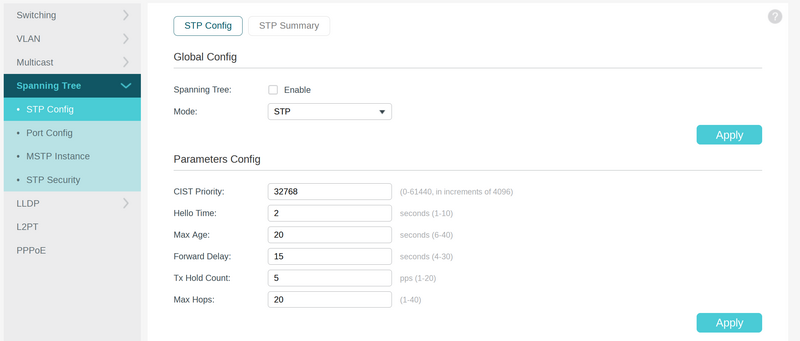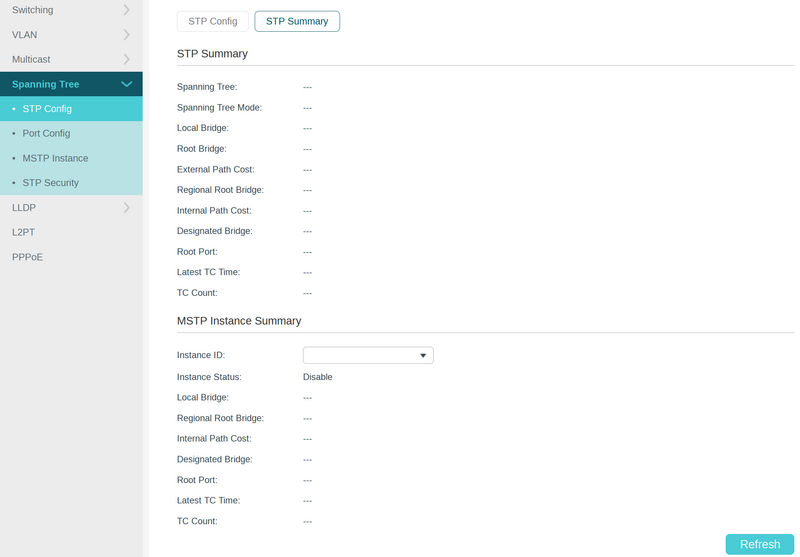T2600G/L2/STP: Unterschied zwischen den Versionen
Keine Bearbeitungszusammenfassung |
Keine Bearbeitungszusammenfassung |
||
| Zeile 1: | Zeile 1: | ||
STP (Spanning Tree Protocol) is a Layer 2 protocol that prevents loops in the network. It helps to ensure a loop-free topology both initially or after topology changes by changing the state of ports. STP can protect the network from broadcast storms and the damage to MAC address. | |||
RSTP (Rapid Spanning Tree Protocol) and MSTP (Multiple Spanning Tree Protocol) are technological improvements on STP. RSTP provides a much faster speed of spanning tree convergence than STP. MSTP can also provides a faster spanning tree convergence speed and in addition can work with VLANs. With MSTP, different VLANs map to different spanning trees (MST instances) and the traffic is separated into different spanning trees so that MSTP can implement load balancing | |||
To configure STP/RSTP: | |||
Step1: | |||
Enable Spanning Tree globally, choose the mode as STP or RSTP, and configure the global parameters. | |||
Step2: | |||
Go to the Spanning Tree > Port Config page, enable spanning tree for ports, and configure the other port parameters. | |||
To configure MSTP: | |||
Step1: | |||
Enable Spanning Tree globally, choose the mode as STP or RSTP, and configure the global parameters. | |||
Step2: | |||
Go to Spanning Tree > Port Config page, enable spanning tree for ports, and configure the other port parameters. | |||
Step3: | |||
Go to Spanning Tree > MSTP Instance, configure the region and instance parameters. | |||
Global Config | |||
Here you can enable the spanning tree function globally and choose the spanning tree mode. | |||
Spanning Tree | |||
Enable or disable the spanning tree function globally. | |||
Mode | |||
Select the spanning tree mode. | |||
STP | |||
Set the spanning tree mode as STP. It is the basic spanning tree protocol based on IEEE 802.1d. | |||
RSTP | |||
Set the spanning tree mode as RSTP. RSTP has the same function as STP, but it can speed up the spanning tree convergence. | |||
MSTP | |||
Set the spanning tree mode as MSTP. MSTP can work with VLANs and implement load balancing. | |||
Parameters Config | |||
Here you can configure the global parameters for spanning tree. | |||
CIST Priority | |||
Specify the CIST priority for the switch. CIST priority is a parameter used to determine the root bridge for spanning tree. The switch with the lower value has the higher priority. | |||
In STP/RSTP, CIST priority is the priority of the switch in spanning tree. The switch with the highest priority will be elected as the root bridge. | |||
In MSTP, CISP priority is the priority of the switch in CIST. The switch with the higher priority will be elected as the root bridge in CIST. | |||
Hello Time | |||
Specify the interval between BPDUs' sending. It works with the MAX Age to test the link failures and maintain the spanning tree. | |||
Max Age | |||
Specify the maximum time that the switch can wait without receiving a BPDU before attempting to regenerate a new spanning tree. | |||
Forward Delay | |||
Specify the interval between the port state transition from listening to learning. It is used to prevent the network from causing temporary loops during the regeneration of spanning tree. The interval between the port state transition from learning to forwarding is also the Forward Delay. | |||
Tx Hold Count | |||
Specify the maximum number of BPDU that can be sent in a second. | |||
Max Hops | |||
Specify the maximum BPDU counts that can be forwarded in a MST region. A switch receives BPDU, then decrements the hop count by one and generates BPDUs with the new value. When the hop reaches zero, the switch will discard the BPDU. This value can control the scale of the spanning tree in the MST region. | |||
==STP Config== | |||
===STP Config=== | ===STP Config=== | ||
[[Datei:T2600G-SpanningTree.png|800px|T2600G:SpanningTree]] | [[Datei:T2600G-SpanningTree.png|800px|T2600G:SpanningTree]] | ||
===STP Summary === | |||
[[Datei:STP Summary.png|alternativtext=STP Summary|800px|STP Summary]] | [[Datei:STP Summary.png|alternativtext=STP Summary|800px|STP Summary]] | ||
==Port Config== | |||
[[Datei:SpanningTree-PortConfig.png|alternativtext=Spanning Tree: Port Config|800px|Spanning Tree: Port Config]] | [[Datei:SpanningTree-PortConfig.png|alternativtext=Spanning Tree: Port Config|800px|Spanning Tree: Port Config]] | ||
==MSTP Instance== | |||
==STP Security== | |||
[[Kategorie:T2600G:L2]] | [[Kategorie:T2600G:L2]] | ||
Version vom 25. Dezember 2022, 14:23 Uhr
STP (Spanning Tree Protocol) is a Layer 2 protocol that prevents loops in the network. It helps to ensure a loop-free topology both initially or after topology changes by changing the state of ports. STP can protect the network from broadcast storms and the damage to MAC address. RSTP (Rapid Spanning Tree Protocol) and MSTP (Multiple Spanning Tree Protocol) are technological improvements on STP. RSTP provides a much faster speed of spanning tree convergence than STP. MSTP can also provides a faster spanning tree convergence speed and in addition can work with VLANs. With MSTP, different VLANs map to different spanning trees (MST instances) and the traffic is separated into different spanning trees so that MSTP can implement load balancing To configure STP/RSTP:
Step1:
Enable Spanning Tree globally, choose the mode as STP or RSTP, and configure the global parameters.
Step2:
Go to the Spanning Tree > Port Config page, enable spanning tree for ports, and configure the other port parameters.
To configure MSTP:
Step1:
Enable Spanning Tree globally, choose the mode as STP or RSTP, and configure the global parameters.
Step2:
Go to Spanning Tree > Port Config page, enable spanning tree for ports, and configure the other port parameters.
Step3:
Go to Spanning Tree > MSTP Instance, configure the region and instance parameters.
Global Config
Here you can enable the spanning tree function globally and choose the spanning tree mode.
Spanning Tree
Enable or disable the spanning tree function globally.
Mode
Select the spanning tree mode.
STP
Set the spanning tree mode as STP. It is the basic spanning tree protocol based on IEEE 802.1d.
RSTP
Set the spanning tree mode as RSTP. RSTP has the same function as STP, but it can speed up the spanning tree convergence.
MSTP
Set the spanning tree mode as MSTP. MSTP can work with VLANs and implement load balancing.
Parameters Config
Here you can configure the global parameters for spanning tree.
CIST Priority
Specify the CIST priority for the switch. CIST priority is a parameter used to determine the root bridge for spanning tree. The switch with the lower value has the higher priority. In STP/RSTP, CIST priority is the priority of the switch in spanning tree. The switch with the highest priority will be elected as the root bridge. In MSTP, CISP priority is the priority of the switch in CIST. The switch with the higher priority will be elected as the root bridge in CIST.
Hello Time
Specify the interval between BPDUs' sending. It works with the MAX Age to test the link failures and maintain the spanning tree.
Max Age
Specify the maximum time that the switch can wait without receiving a BPDU before attempting to regenerate a new spanning tree.
Forward Delay
Specify the interval between the port state transition from listening to learning. It is used to prevent the network from causing temporary loops during the regeneration of spanning tree. The interval between the port state transition from learning to forwarding is also the Forward Delay.
Tx Hold Count
Specify the maximum number of BPDU that can be sent in a second.
Max Hops
Specify the maximum BPDU counts that can be forwarded in a MST region. A switch receives BPDU, then decrements the hop count by one and generates BPDUs with the new value. When the hop reaches zero, the switch will discard the BPDU. This value can control the scale of the spanning tree in the MST region.


